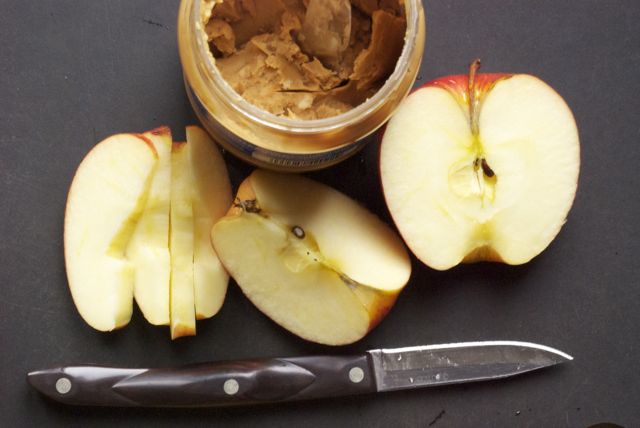
reference-image, l
(article, Marissa Lippert)
[%pageBreakSettings nobreak=true] It's January — traditionally the month when we rue all the sweet treats and carbohydrate-rich goodies of the winter holidays. We try to scale back, pare down, simplify. We make vegetable soups and eat whole grains. Gradually, we start to feel a bit better about all that end-of-year excess. But if there are kids in the household, all that residual guilt is compounded by worries about their future. Are they forming good habits that will last them a lifetime? Worse, how are their dietary preferences influencing their physical and psychological health? Refined sugars and carbohydrates — the stuff everybody loves to eat, and eat too much of — are the usual suspects here. "Oh, he's bouncing off the walls from all that sugar he ate earlier today," we've heard parents sigh. Can cutting back on sugar and carbs really make a difference? [%image reference-image float=right width=400 caption="Apple slices spread with peanut butter are a balanced, healthful snack."]The scientific jury is still out. Some studies have found that dietary interventions for kids with such diagnoses as attention-deficit hyperactivity disorder (ADHD) and autism are ineffective, while other findings and personal testaments claim that elimination diets can help. According to the Centers for Disease Control, in the U.S. some 5.3 million kids ages 3 to 17 have ADHD, while 1 in 110 children have autism. Both conditions range widely in their severity and symptoms, making it difficult to assess whether a dietary change that seems to help one child is truly the key to helping another. That said, here are some simple dietary alterations that could encourage positive shifts in digestion, behavior, and communication in children with ADHD or autism. h3. Attention-deficit hyperactivity disorder (ADHD) A recent Australian study found that “Western diet” patterns — favoring foods high in processed ingredients, total and saturated fat, sodium, and sugar, as well as shunning foods rich in healthy omega-3 fats — may contribute to a greater incidence of ADHD. Other research indicates that significantly decreasing or wholly eliminating refined sugars and carbs — meaning not just sugar but the whole “white” category of refined pastas, breads, flours, and rice — may have noticeable effects on people with ADHD. Why? Because refined sugars and refined carbohydrates are far too easily digested, spiking both blood sugar and energy levels and decreasing the ability to concentrate and pay attention. Everybody — not just kids with ADHD — will probably see marked improvement when their diets include more whole grains and complex carbohydrates, such as brown rice, whole-grain breads and cereals, fruit, vegetables, and snack items that are higher in fiber (aim for at least 3 grams of fiber per serving). The combination of higher fiber and a broader nutrient base slows down digestion, keeping energy levels more steady. In addition to healthy unsaturated sources of fat, omega-3 fats like those found in salmon, walnuts, flaxseed, and olive oil may help improve ADHD symptoms. If a child isn’t going to go near a salmon fillet or doesn’t like the texture of flaxseed, a daily supplement may be a smart choice. Pairing some peanut butter with apple slices for a snack, or serving whole-wheat pasta with lean meatballs and a chunky tomato sauce for dinner, keeps things well balanced with a mix of protein, complex carbs, and healthful fats. Growing up with a childhood friend who had ADHD, all I vaguely recall was that artificial colorants were an absolute “no-no.” Of course, artificial flavorings, colorings, additives, and preservatives don’t do a whole lot of good for anyone, so it’s best to leave them out of the picture whenever possible. h3. Autism Though some studies find otherwise, getting gluten out of her diet may help a child with autism. "Gluten-free" translates to “no wheat, spelt, rye, barley, and commercially produced oat products“ in addition to certain food additives and thickening agents. The list of forbidden foods can be daunting if you buy a lot of processed foods and have to start reading lengthy ingredient lists to spot the bad guys. But if you stick with healthy whole foods, the process of elimination and exchange for standard breads and pastas becomes much easier. [[block(sidebar). h1. Online resources Autism Society The Feingold Center for Children ]] Rice, potatoes, chickpeas and beans, quinoa, and hearty winter squashes are all on the “green light” list. These days, there are also plenty of gluten-free breads, pastas, flours, and baking mixes available in grocery stores and online. Of course, there are also plenty of gluten-free baked goods and sweets out there, too. But parents may find that moderating amounts of these items additionally improves the status of an autistic child. Along with gluten, removing casein can also have positive results for autism. Casein is a type of protein found in dairy products like cow’s milk, cheese, butter, and cheese products. Many sources recommend going completely dairy-free and eliminating whey protein as well. If a casein-free or dairy-free diet is followed, remember to make sure the child is getting another source of calcium and vitamin D. (You can also ask your pediatrician to recommend a supplement.) Less-allergenic milk options, such as rice and almond milks, can provide a good calcium-rich alternative.

reference-image, l